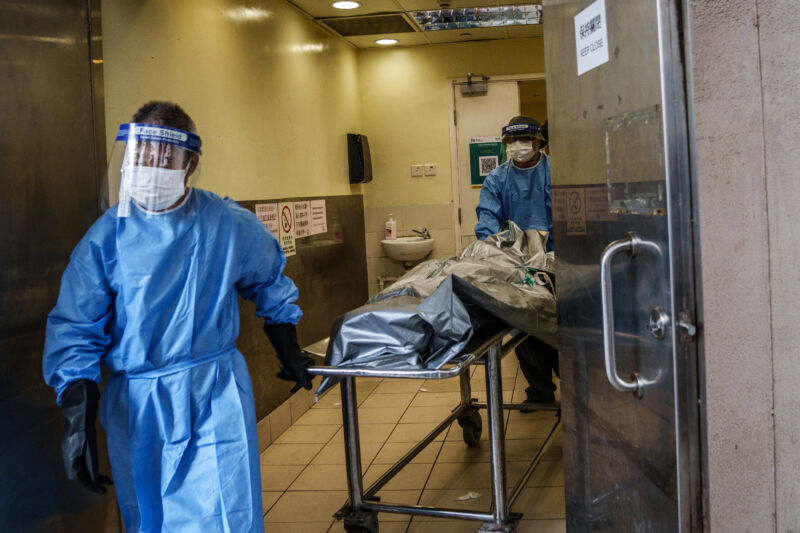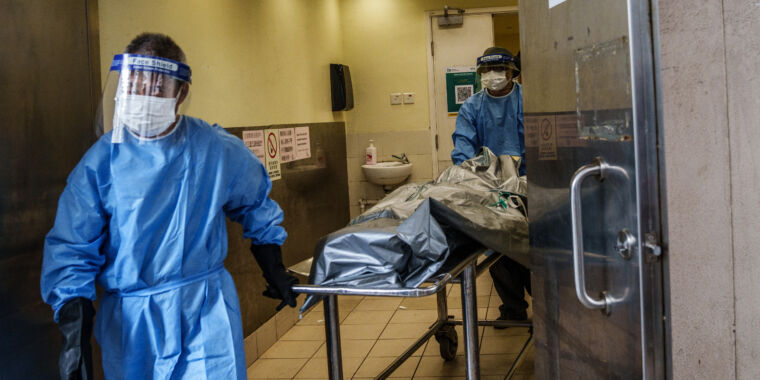
For much of the pandemic, China kept the coronavirus at bay. The country adopted an aggressive COVID-Zero plan, rigorously identifying, containing, and tracing cases to prevent the viral spread. It appeared to work remarkably well—until the arrival of the ultratransmissible omicron variant.
The seemingly uncontainable virus is now exploding in China, smashing records daily and laying bare a tragic fault in China’s COVID policies: the country’s most vulnerable—older people—are among the least protected by vaccination. As such, death rates are bound to soar.
This has already played out in Hong Kong, which saw its own towering omicron wave between January and March. In its wake was one of the highest death rates the world has seen amid the pandemic. In a study published Friday by the Centers for Disease Control and Prevention, the US CDC partnered with the CDC China for a postmortem on the deadly spike. The analysis highlighted the fatal flaw when neglecting to vaccinate older people.
As of late December 2021, about 67 percent of vaccine-eligible Hong Kong residents were vaccinated with at least one dose. About 64 percent had two doses, and just 5 percent had boosters. But the numbers went downhill with age. Of people ages 60 and up, only 52 percent had one dose or more. For those ages 70 to 79, only 48 percent had at least one. And for those ages 80 and above, a mere 20 percent had at least one dose.
On January 6, officials in Hong Kong detected the city’s first cluster of omicron cases, sparking an outbreak that peaked March 4. By March 21, officials had recorded a total of 1,049,959 cases and 5,906 COVID-19–associated deaths. The mortality rate was 38-per-million people, one of the highest in the world.
Deadly mistake
Of the 5,906 COVID-19 deaths during the omicron wave, 96 percent were among people ages 60 and above. Overall, comparing death rates with people under age 30, people 60 and up were 253 times more likely to die, and people 80 and up were 946 times more likely to die. Of the people 60 and up who died, 70 percent (3,970 of 5,655) were unvaccinated, and an additional 18 percent (1,023 of 5,655) had only gotten one vaccine dose. Overall, unvaccinated people ages 60 and up were 21 times more likely to die than people in the age group who had at least two doses.
It’s unclear why relatively few older adults in Hong Kong and elsewhere in China got vaccinated. The CDC authors of the analysis noted that a June 2021 survey in Hong Kong found that 57 percent of people were hesitant about or resistant to COVID-19 vaccines. “The dynamic COVID-Zero strategy, successful until the emergence of the omicron variant, might have resulted in further complacency, particularly among older persons,” the authors speculated.
They noted that since the omicron wave began, vaccination among older adults has increased “substantially.” As of March 21, vaccination among people ages 60 to 69 rose from 65 percent to 81 percent; in those ages 70 to 79, vaccination rose from 48 percent to 69 percent; and among those 80 and above, vaccination rose from 20 percent to 39 percent. Still, those numbers are low compared to those in the US and Europe. And on mainland China, only about half of those aged 80 and above have been fully vaccinated, according to data from March.
As omicron surges in Shanghai, the analysis provides a clear call to action. “This report underscores that vaccination reduces COVID-19 mortality rates in older adult populations and calls attention to the importance of monitoring age-specific vaccination coverage, identifying disparities in age-specific vaccination rates, and addressing those coverage gaps,” US CDC wrote in a statement.








